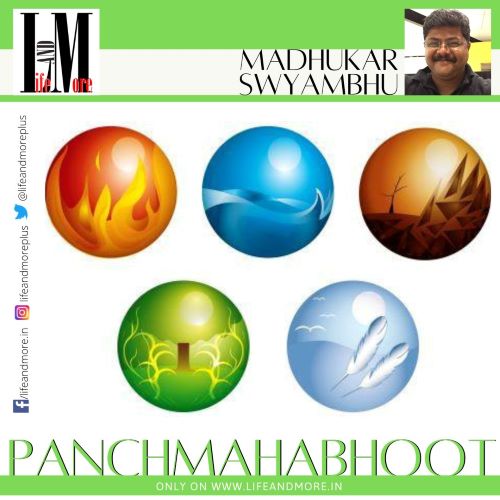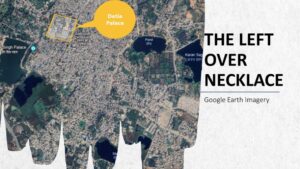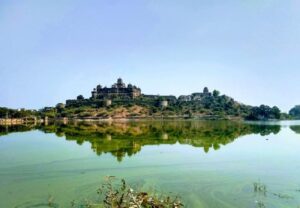DATIA – A TOWN PLANNING MARVEL

Rain water harvesting that is usually taken to be a Western thought process of the recent times has been a part of the Indian culture since time immemorial. Not just Rain Water harvesting, in Bharat, we even had the concept of flood Water harvesting. There have been numerous examples of Water intelligent city planning done in the country and even those places which are no more a part of Bharat today. For example, we have Dholavira, Harappa, Angkor Wat… the list goes on.
The Bundelkhand region, presently divided into the states of Madhya Pradesh and Uttar Pradesh, is a wonderful example of the same. And today, we’ll focus on one of the marvels of sustainable city planning in absolute harmony with Nature, understanding the weather cycle, physics, geology and hydrology. We’ll discuss about the city of DATIA.
The town of Datia was a part of Orchha state – the capital of Bundelkhand. Designed on a rocky plateau with no source of natural Water, the city was planned and designed in such wonderful way that it never saw a drought in over a millennium. That’s why it qualifies as an engineering and town planning marvel.
THE FOLKLORE
The tale goes like this, “One of the Bundela kings had four sons, so there was a dilemma regarding the successor. Especially, because the King wanted to give the responsibility to the most deserving son. So, he planned a competition among the four princes. He gave a task to each one of them to design a sustainable city at par with the capital city of Orchha. Since, the kingdom was completely on a rocky plateau, designing a sustainable city without water was a big challenge, but making such a city would exhibit a wonderful planning of the designer. Thus, all four princes, started upon the journey to plan out a city. Three of them failed. The fourth one, who succeeded was the one who designed, planned and formed the city of Datia. It was such an impeccable and beautifully-designed city that the water abundance ensured that there wasn’t any drought like condition for next 1000 years in the city”.
DATIA: A SUSTAINABLE CITY
The rulers of Bundelkhand appear to have taken keen interest in the rainwater harvesting structures. Large numbers of extant structures stand witness to it. The construction of water- bodies assumed particular significance for rulers which would provide a sound and solid base to the economic state. Further, the geographical and topographical impediments necessitated it. The region is enormously hilly and rocky with a steep land gradient hence water flows quickly and absorption is quite low. This situation is responsible for the deep water-table and low water resource in the region. The less rainfall further multiplied the problem on the water front. Keeping these difficulties in mind, the Chandela and the Bundela rulers took keen interest in rainwater harvesting.
Tanks were constructed in large numbers by these rulers. That there existed at least one tank in each of the villages is confirmed from the inscriptions, gazetteers and the Archaeological survey reports. Some villages have more than one tank, built by rulers, nobles, traders, banjaras and the other individuals. References of these waterbodies are available in large numbers. Inscriptions and the literary sources mention the construction of waterbodies by Madan Varman (1128-1165), Parmardideva (1165-1203) Vir Varman (1245-1285) and others.
Datia was formerly a part of Orchha state ruled by Maharaja Bir Singh Dev and he had built a fort palace there on the bank of a lake. Later on, the pargana was given in jagir to his son Bhagwan Das, after which it remained in his family .But, after the demise of Bir Singh Dev, it emerged as an independent state.
Datia is a beautifully planned town in the heart of Bundelkhand region of the state of Madhya Pradesh, especially in terms of the water resource planning. The town was planned with a necklace of lakes around it in such a way that the overflow of one lake used to fill up the other lakes, so as to avoid and drought situation around the year for any part of the town. In local dialect, Datt (दत) means Rock stone, that formed the name Datia (दfतया) meaning rocky plateau, and therefore the water resources were planned before planning the town in the otherwise unfriendly terrain. The city has seven tanks, namely, Sita Sagar, Karan Sagar, Ram Sagar, Laxman Tal, Lala ka Tal or Bir Sagar. All these waterbodies are connected with each other. The location of these tanks indicates a definite planning. It appears that these waterbodies are dug in descending order. First tank was excavated at comparatively higher plain and then others were excavated in succession at lower sites. All are designed in such a way that a overflow of one tanks fills the tanks located at lower level. Through linking of waterbodies, the hydraulic engineers created a web of tanks. This, in fact, is an ingenious method adopted to collect running surface water into tanks. This area receives good rains and the annual average rainfall is between 60 and 70cm, between 1901 and 1950 the annual rainfall was highest which, was 167 percent. Rainfall has been quite sufficient. Therefore, the hydraulic engineers developed waterbodies accordingly. Their main concern was to tap each and every drop of rain water to be used for irrigating fields, drinking and other domestic purposes. There are some tanks which are linked and make a necklace (सांकल = chain), kind of structure surrounding the fort.
Sita Sagar water body
LALA KA TALAB AKA BIR SAGAR
This waterbody exists in the backside of the fort-palace known as the Satkhanda Mahal or Bir Singh Mahal. The tank was built by Bir Singh Dev at the time when he was the Jagirdar (lala) of Baroni located eight km away from Datia. It is an enormous lake. The combined impact of both creates a scene of fairy dreamland. Now, local people call this lake after his name, as Lala-ka-taal.
Datia Fort
On the back-side of the embankment or on the comer of the retaining wall there are two wells probably for irrigating surrounding fields. One of the wells is still actively used by Water Works Department for supplying drinking water to the residents of the area. Behind the retaining wall there is probably an orchard which receives water from this waterbody and produces variety of fruits probably for the members of the royal family.
The lake is man-made and is surrounded by construction work at all four sides, while on one side it has the fort, the other two has religious sites and the fourth has a ghat. Thus, engineers encircled the waterbody from three sides. The wall in the eastern direction gets the support of the hillock running parallel to the waterbody. Thus, water coming from the southern direction is blocked from three sides. On the basis of the fieldwork a following ground plan is prepared indicating two safety valves, two religious structures and one Ghat. Putting pressure on the safety valves used to release pressure to release water from the Ghat which, would be used for canal irrigation and filling up of the nearby lakes and other waterbodies.
CONCLUSION
If the city planning is done, keeping the natural resource planning in focus, marvels get created. And in Bharat we had this wisdom even 1000 years back to create sustainable cities with holistic planning. This was no Vedic era, but the recent history, because our timeline is over 25,000 years old and we are the oldest continuous surviving civilisation on the planet and we still have the youngest population on the planet.
Madhukar Swayambhu is known for his career in IT communication network industry for over two decades followed by his almost a decade long work in the environment ecology, Indic Knowledge System (IKS), and his invention of Cownomics® Technology, which is globally the most recognised, endorsed, certified, standardised and appreciated technology in Climate Tech space, which is completely based on Indian Vaidic Sciences.
A TED speaker, he has been decorated with various national and international awards, including Water Hero, by the Union Ministry of Jal Shakti, and has been recognised as globally No. 2 author by Smart Water Magazine, Spain.





